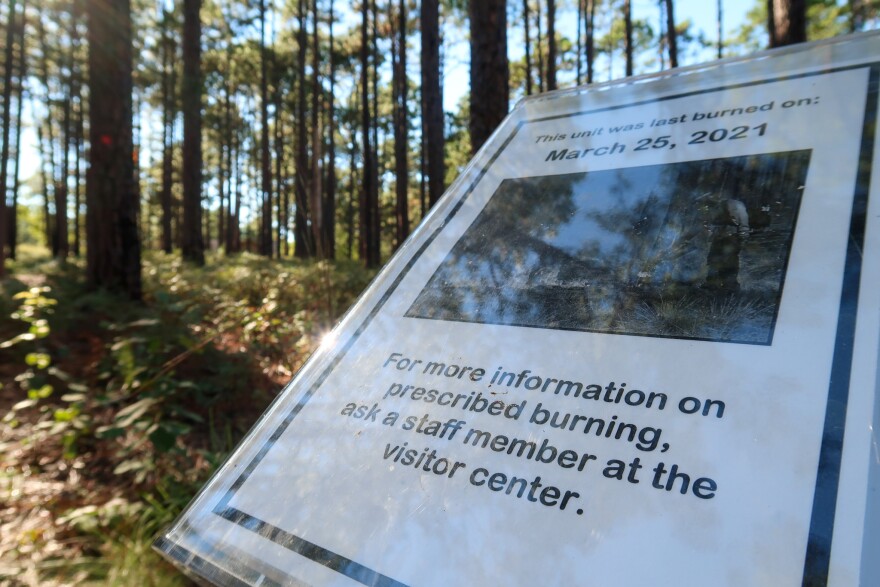The longleaf pine is an iconic tree species in North Carolina. It once covered 90 million acres across the Southeastern United States.
But today, less than 5 million acres remain.
For decades, the tree was chopped down for timber. It was also used for its resin, which coated the hulls of 18th-century ships and drove the shipbuilding economy.
Today's forest owners can still clear-cut and sell for timber. They can also leave the trees standing, and collect and sell the pine needles in a multimillion-dollar industry.
Now, growing research offers another potential incentive: Longleaf pine is especially resilient to climate change.
"The (longleaf) forest provides all sorts of services in terms of our water quality and water quantity and our resiliency to storms," said Sarah Crate, who works with the Longleaf Alliance, a national organization dedicated to managing and restoring longleaf pine forests.
As Crate walked around at Weymouth Woods Nature Preserve in Southern Pines, she explained that longleaf pine trees thrive under prescribed fire, which reduces the risk for wildfires.
"So that's a really important way they create resiliency, because we know with a changing climate there are more opportunities for those wildfires," Crate said. "But it's not just the fire aspect that creates a more resilient tree. (The roots of) longleaf pine grows ... down, and that focus of energy in the root system creates a sturdy, stable tree. So that in wind events, such as hurricanes, they are not as susceptible to wind damage compared to some other pines."
Similar to wildfires, experts suggest that wind events, including hurricanes, will become more severe and more frequent as climate change continues.
Longleaf pine trees are notably resistant to insect infestations and provide a healthy habitat for endangered species, including the red-cockaded woodpecker and gopher tortoise.
Additionally, longleaf helps manage water by increasing water yield — the runoff to streams and rivers.
"If you have an ecosystem like longleaf pine, that tends to use less water, that means more ... precipitation is leftover to get into your streams, rivers, wetlands, and groundwater," said Steven Brantley, an ecohydrologist at the Jones Center in Newton, Georgia.
Brantley has written several research articles about longleaf pines and their role in today's changing climate. He explained longleaf pine trees take in less water as a whole, but, more importantly, use less water when it's scarce.
"What longleaf pine does typically is it can reduce its water use during periods of scarcity, and increase its water use when the water is plentiful," Brantley said. "Whether that's a typical drought year or more severe droughts from climate change, longleaf tends to balance its water use against what the climate is providing it at the time."
Another important aspect of longleaf, and all trees, is carbon sequestration, which is the process of removing and storing carbon dioxide from the atmosphere. Longleaf pine trees sequester carbon over a longer period of time.

"Runners are a good analogy for this. If you ask: who's the fastest runner? Well, are you talking about 100 meters? A mile? 26 miles? A loblolly pine can sequester a lot of carbon in a year, so it's like the sprinter," Brantley said. "But longleaf probably has a better long-term forecast in terms of sustained carbon sequestration that's going to be resilient to climate change."
"(Longleaf's resiliency) just gives us another way to promote the species and the plant community."Phil Wallace
But there's a balancing act when it comes to longleaf and releasing carbon. Prescribed fires used to manage the pine tree ecosystem actually emit carbon dioxide into the atmosphere. However, the amount of carbon released is less than if no prescribed fires took place and a wildfire happened.
"There's a plus side and a negative side to fire," Brantley said. "There's a saying in forestry: you either burn now, or you're going to burn later."
Proper management of longleaf is the key component for the tree to deliver on its resiliency. In North Carolina, most of the management falls to private landowners, according to Phil Wallace with the North Carolina Forest Service.
"We’ve seen a huge shift in reasons why people own property here in North Carolina," Wallace said. "Years ago, it was all about timber production. We're seeing a lot of that change now. Landowners have a stronger interest in ... improving wildlife habitat and restoring the natural function."
Wallace has a background in longleaf pine management and is the staff forester for silviculture. A lot of his work is collaborating with landowners to make sure that management and restoration happen.
"People have a much better understanding today of ecological values that longleaf provides," Wallace explained. "Improved water quality and carbon sequestration are two of those that can be selling points as we move forward with new and diverse landowners to say, 'Hey, longleaf is a really good choice not only from the traditional timber species ... but for those ecological services.'"

This shift in thinking may come from older generations handing off their land to younger generations, like millennials, who will make choices using a different value structure.
The resiliency of longleaf pine is another strength conservationists can use to convince private landowners to invest in restoring the iconic tree.
"It just gives us another way to promote the species and the plant community," Wallace said. "We've always known as professionals that restoring the natural function and natural ecosystem is a good thing. (Longleaf's resiliency) just gives us another tool to ... give landowners the opportunity to restore this community."
Copyright 2021 North Carolina Public Radio. To see more, visit North Carolina Public Radio.

